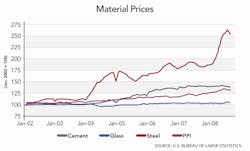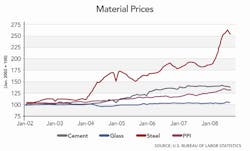What Lies Ahead for Building Materials and Products
By Andrew Bohutinsky and Carlos Galvez
The financial crisis that started in the second half of 2007 has had a significant effect on the broader economy. The losses suffered by most financial institutions have resulted in lower availability of credit, tighter credit standards, and higher borrowing costs for U.S. businesses.
As most banks rush to raise and conserve capital, businesses are facing ever-higher hurdles to finance investments and operations; consumers are finding that they can't afford to maintain previous spending habits without having easy access to credit.
Both of these trends are weighing heavily on the current outlook for the U.S. economy. At press time, economists surveyed by the Wall Street Journal expected that GDP will contract by 3 percent at an annualized rate in the fourth quarter of 2008, while the Organization for Economic Cooperation and Development expects U.S. economic activity to fall by 0.9 percent in 2009.
The economic downturn will impact the level of nonresidential construction, which, up until this point, has been a relatively healthy sector in the building and construction industry. While this cycle hasn't been characterized by the same patterns of overbuilding that preceded previous busts in commercial construction, demand for many nonresidential buildings - including office space, factories, and retail - is expected to decrease because it closely mirrors economic activity.
The credit crisis also affects the ability of developers to finance new building projects. According to the Federal Reserve's survey of loan officers, lending standards for commercial real estate loans have tightened significantly in the last year. The combination of reduced demand and the difficulty of finding financing will likely result in a significant reduction in new-construction activity and postponement of planned construction projects. McGraw-Hill expects commercial building construction starts in 2009 to amount to $79 billion, which is a 12-percent decrease from 2008.
Decreased Demand for Commodities Causes Ripple Effect
The prospect of an economic downturn has reduced forecasted demand for most commodities, including oil, gas, and most metals. Major commodities have already declined steeply from their price levels during Summer 2008. Oil futures, which traded as high as $145 per barrel in July, were trading below $60 in November. Natural gas futures also decreased from a high of $13.58 per million BTU in July to $6.41 in November.
While the overall economic outlook is grim, developers and owners who have the resources to embark on new projects may enjoy some benefits. Material prices, which outpaced inflation in recent years, will likely follow other commodity prices downward to some degree. In particular, steel prices have been dropping recently from their near-record levels earlier this year. After rising steeply during the first part of 2008, structural steel finally seems to be softening, receding in September for the first time in 2008 due to restocking and weak demand. In addition, according to Steel Business Briefing, steel prices have fallen sharply in recent months. For example, the price of rebar reached $610 per short ton in November - a 35-percent decline from October's price of $935 per short ton. While major producers are trying to voluntarily curb production to decrease the rate at which inventory is building, steel prices are forecasted to remain below their recent highs for the rest of the year, and through 2009.
Cement prices have also shown signs of weakening in recent months, falling by 1.5 percent from their yearly high in June 2008. Data from the U.S. Bureau of Labor Statistics used in the calculation of the Producer Price Index (PPI) indicates that cement prices have remained relatively stable since April 2007, compared to a 9.7-percent increase in the PPI. Continuing weakness in the construction sector will likely prevent cement manufacturers from raising prices in the near future, contributing to our expectation of flat or slightly lower prices in 2009.
Reductions in commodity prices will favorably impact the cost structure of most building-products manufacturers, reducing pressure from their input costs and improving their ability to weather the downturn in construction activity; however, since most manufacturers haven't been able to offset inflation in the cost of their raw materials with price increases, lower commodity prices aren't likely to translate into lower prices for finished building products in the near term.
Andrew Bohutinsky is a managing director at Lincoln Intl., an investment banking firm that specializes in merger and acquisition activity, and the raising of private capital for organizations involved in mid-market transactions. Carlos Galvez works closely with Bohutinsky in Lincoln Intl.'s building and construction group. They can be reached at (312) 580-2805, [email protected], or [email protected].

